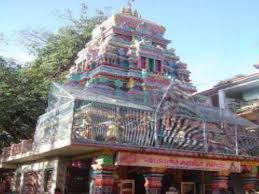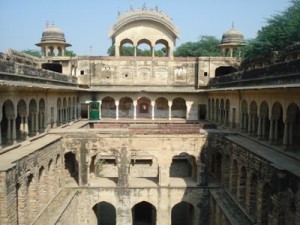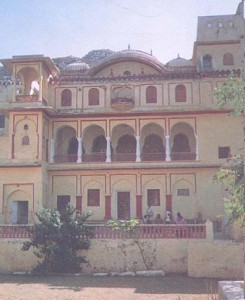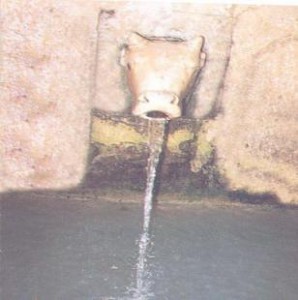Tourist Attraction of Dausa
Dausa ( An Archeological City ) ( Land of Gods )Situated on National Highway No. 11, 55 km east of Jaipur, Dausa is an ancient town of archeological importance. It had the privilege of being the first headquarter of erstwhile Kachhawaha rulers of Dhundar. Carlyle in the year 1871-72 AD found a number of stone circles on the sloping grounds to the north of the foot of the hill. One or two of them contained cromlechs, a few cairns and sepulchral mound of prehistoric date. Daya Ram Sahni, an archaeologist, also visited Dausa and discovered other interesting antiquities which are believed to belong to the late medieval period.

Temple of Bajrang Bali (Hanuman) god is famous for treatment of mentally disturbed people by the PRETRAJ.With the tremendous growth in medical sciences in the world, still people from all over India come to this place to overcome such diseases. The number of visitors turn-up, number of residential accommodations and volume of donations receivedby the temple show the importance of this place. It is situated about 40 Kms from district headquarter on NH11 towards Mahwa/Agra.
Neelkanth Panch Mahadev Temple
Dausa is also known as DEVNAGRI. In fact, Sahajnath, Somnath, Gupteshwar & Neelkanth, the five images of God Shive (Mahadev) are situated in the temples at Dausa. The temple of Neelkanth, situated on the plateau of the nearby hill, shows its ancient glory and spiritual presence. The roap-way alsoattracts the tourists to enjoy the faith of this religious place.
Bhandarez
Bhandarej is famous for walls, sculptures, decorative lattice work, terracotta utensils etc found in excavation. It is situated at about 10 Kms from thedistrict headquarter towards Sikandra on NH-11. The Bhandarej Baori (Step Well) and Hotel Bhadravati Palace are important places to visit. The Baori is a magnificent architectural creation and has 150 wide steps going towards the main well, approximately 70 feet in width. The Palace is an interesting blend ofboth Mughal and Rajput architecture having courtyards, arched windows and traditionally painted verandahs.

ABHANERI
Abhaneri is famous for its Post-gupta or early medieval monuments. It is situated at about 33 Kms from the district headquarter towards Bandikui. The Chand Baori(Step Well) and Harshat Mata Temple are the important places to visit. The temple is an execellent example of intricate carving onstone whereas the Baori has stairs with unparallel artistic and architectural beauty.
Khawaraoji
Khawaraoji is famous for residence</b> of the then rular Raoji and natural beauty. It is situated at about 25 Kms from the district headquarter towards Sikrai. Though, it has typical way to reach this place, the fort like residence is converted into the Khawaraoji Heritage Hotel. Surrounded by hills at the three sides, and having Amol Ghati nearby with natural beauty, this place has worth to visit by tourists.
Jhajirampura
Jhajhirampura is famous for the natural water tank and temples of Rudra (Shiv), Balaji(Hanuman) and other religious god and godess. It is situated at around 45 Kms from district headquarter towards Baswa (Bandikui). Surrounded by hills and with natural water resource, this place has natural and spiritual glory.
The Dargah of Hazrat Khwaja
Jamaluddin Shah Baba (a dargah is the tomb of a Muslim saint) is a renowned one and is frequented by Hindus and Muslims alike, not just from within dausa but from nearby stations as well. The dargah itself is a modest building located in peaceful surroundings. It is generally believed that nobody ever returns from there without getting one's wishes fulfilled. The sleepy little town comes alive on Mondays when a special market springs up. Leather merchants from nearby places gather here to sell their camel leather goods and fine sheets of raw leather.
Harshat Mata Temple
Today Abhaneri is mainly famous for the Harshat Mata Temple belonging to the 9th century. of course, only portions of this ancient shrine remain now, like the sanctuary walls, terrace and something of the columned mandapa (forechamber). The sanctum, shorn of its superstructure, is enclosed in an ambulatory and is pancharatha (with five offsets) in structure. The walls have carved niches in which are images of other deities.
These worn out images indicate that the temple was originally dedicated to Vishnu, the Creator of the Hindu trinity of Creator Preserver-Destroyer. The architectural details of the terrace basement is more or less complete, showing friezes of geometric ornament and miniature niches with sculptures of seated deities and amorous couples. The columns and walls are adorned with scenes of dance, music, sport and love, although majorly damaged now. Some of the better panels have been shifted to the Archaeological Museum, Amber and the Central Museum, Jaipur. The sanctum now enshrines an image of the four-armed deity Harasiddhi, locally called Harshat Mata. Many images of Hindu deities have been found around the place which are being preserved by the Archaelogical Survey of India. A mela (fair) is held near the temple in the month of Chaitra (March-April) every year.






